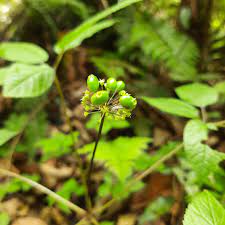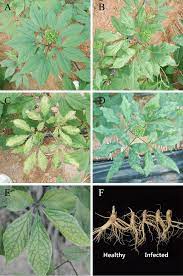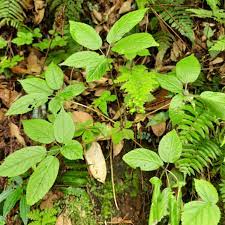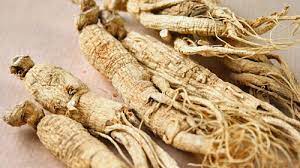Panax pseudoginseng, commonly known as Himalayan ginseng, is a species of perennial herbaceous plant native to the Himalayan regions of Asia, including Bhutan, Nepal, and parts of China and India. It belongs to the Araliaceae family, which also includes other well-known ginseng species like Panax ginseng and Panax quinquefolius.
Himalayan ginseng shares many similarities with other ginseng species and is valued for its potential medicinal properties. Like its counterparts, the root of Panax pseudoginseng is the most sought-after part and is used in traditional medicine systems for various health benefits.
In traditional Tibetan medicine, Himalayan ginseng is believed to have adaptogenic properties, meaning it may help the body adapt to stress and promote overall well-being. It is often used to support cardiovascular health, improve circulation, and enhance vitality.
Cultivation of Panax pseudoginseng typically occurs in mountainous regions with well-drained soil and cool temperatures. The plant requires a relatively long growing season and is usually harvested after three to seven years of growth, depending on the desired quality of the roots.
Himalayan ginseng is commonly prepared as a powder, extract, or tea for consumption. It is also sometimes used as an ingredient in traditional herbal formulations and dietary supplements.
While Panax pseudoginseng is generally considered safe for most people when used appropriately, it may interact with certain medications and have side effects in some individuals. As with any herbal supplement, it’s important to consult with a healthcare professional before using Himalayan ginseng, especially if you have underlying health conditions or are taking medications.
The Botanical Description of Panax pseudoginseng
1. Appearance: Panax pseudoginseng, commonly known as Himalayan ginseng or notoginseng, is a perennial herbaceous plant that belongs to the Araliaceae family. It features slender stems with palmately lobed leaves arranged in a spiral pattern.
2. Height: The plant typically reaches a height of 30 to 60 centimeters, although some specimens may grow taller under optimal conditions.
3. Leaves: The leaves of Panax pseudoginseng are glossy green and consist of three to five leaflets, each with serrated margins. The leaflets are lanceolate or ovate in shape and have prominent veins.
4. Flowers: In late spring or early summer, Panax pseudoginseng produces small white or pale pink flowers arranged in umbels at the ends of the stems. The flowers are attractive to pollinators such as bees and butterflies.
5. Fruit: After flowering, Panax pseudoginseng develops spherical or ovoid fruits that ripen to a dark blue or black color. Each fruit contains several small seeds.
6. Roots: The most valuable part of Panax pseudoginseng is its fleshy roots, which are spindle-shaped and grow horizontally underground. The roots have a slightly sweet taste and a characteristic odor.
7. Habitat: Panax pseudoginseng is native to the mountainous regions of China, Bhutan, India, and Nepal, where it thrives in cool, temperate climates with well-drained soil and partial shade.
8. Cultivation: Cultivation of Panax pseudoginseng typically involves planting root cuttings or seeds in rich, loamy soil with good drainage. The plant requires consistent moisture and protection from direct sunlight.
9. Harvesting: The roots of Panax pseudoginseng are harvested after three to four years of growth when they reach maturity. The roots are carefully dug up, cleaned, and dried before being processed for medicinal use.
10. Traditional Uses: Panax pseudoginseng has been used for centuries in traditional Chinese medicine to promote vitality, improve circulation, and support cardiovascular health. It is also valued for its adaptogenic properties, which help the body cope with stress.
The Geographic Distribution of Panax pseudoginseng

1. China: Panax pseudoginseng is native to several provinces in southwestern China, including Yunnan, Sichuan, and Tibet. It grows in mountainous regions at elevations ranging from 1,000 to 3,000 meters.
2. Bhutan: Panax pseudoginseng is found in the eastern Himalayas of Bhutan, where it occurs in forested areas and alpine meadows above 2,000 meters.
3. India: In India, Panax pseudoginseng is distributed across the eastern Himalayan region, including the states of Arunachal Pradesh, Sikkim, and Himachal Pradesh. It grows in damp, shady forests at high altitudes.
4. Nepal: Panax pseudoginseng is also native to Nepal, where it is found in the central and eastern regions of the country. It prefers cool, moist environments with well-drained soil.
5. Cultivation: In addition to its native range, Panax pseudoginseng is cultivated in other parts of the world with suitable growing conditions, including North America, Europe, and Japan.
6. Conservation Status: Due to habitat loss, overharvesting, and illegal collection, wild populations of Panax pseudoginseng are at risk of decline. Conservation efforts focus on sustainable harvesting practices and the establishment of protected areas to preserve the species’ natural habitats.
The Chemical Composition of Panax pseudoginseng
1. Ginsenosides: Panax pseudoginseng contains a diverse range of ginsenosides, bioactive compounds that contribute to its medicinal properties. These include Rb1, Rg1, Rd, Re, and Rb2, which have antioxidant, anti-inflammatory, and adaptogenic effects.
2. Polysaccharides: The roots of Panax pseudoginseng are rich in polysaccharides, complex carbohydrates that have immune-modulating and anti-cancer properties.
3. Flavonoids: Panax pseudoginseng contains flavonoids such as quercetin, kaempferol, and rutin, which have antioxidant, anti-inflammatory, and anti-cancer effects.
4. Triterpenes: Triterpenes are another group of bioactive compounds found in Panax pseudoginseng, including oleanolic acid, ursolic acid, and betulinic acid.
5. Phytosterols: Panax pseudoginseng contains phytosterols, plant-derived compounds that have cholesterol-lowering effects and may help reduce the risk of cardiovascular disease.
6. Essential Oils: The roots of Panax pseudoginseng contain small amounts of essential oils, which contribute to their characteristic aroma and flavor. These oils have been traditionally used in aromatherapy and topical preparations for their therapeutic effects.
7. Amino Acids: Panax pseudoginseng contains essential and non-essential amino acids important for protein synthesis, neurotransmitter function, and overall health.
8. Minerals: The roots of Panax pseudoginseng are a good source of minerals such as calcium, magnesium, potassium, and iron, essential for various physiological processes.
9. Vitamins: Panax pseudoginseng contains vitamins A, C, and E, as well as B-complex vitamins like riboflavin, niacin, and folate, supporting overall health and immune function.
10. Enzymes: Enzymes such as amylase, protease, and lipase found in Panax pseudoginseng roots aid in digestion, nutrient absorption, and metabolic processes.
Read Also: Economic Advantages and Management of Fishery Resources
The Medicinal Health Benefits Of Panax pseudoginseng (Himalayan ginseng)

1. Cardiovascular Support: Panax pseudoginseng supports heart health by lowering blood pressure, improving circulation, and reducing the risk of cardiovascular disease.
2. Stress Relief: Its adaptogenic properties help the body cope with stress by modulating the stress response system and reducing cortisol levels.
3. Immune Modulation: Panax pseudoginseng enhances immune function, helping the body fight infections and diseases more effectively.
4. Anti-inflammatory Effects: It exhibits anti-inflammatory properties, reducing inflammation in the body and alleviating symptoms of inflammatory conditions.
5. Cognitive Function: Panax pseudoginseng may improve cognitive function, memory, and concentration, enhancing mental clarity and alertness.
6. Energy Boost: It boosts energy levels and endurance, increasing physical stamina and reducing fatigue.
7. Antioxidant Protection: Panax pseudoginseng scavenges free radicals, protecting cells from oxidative damage and premature aging.
8. Blood Sugar Regulation: It helps regulate blood sugar levels, supporting metabolic health and reducing the risk of diabetes.
9. Wound Healing: Panax pseudoginseng promotes faster wound healing and tissue repair, accelerating recovery from injuries and surgeries.
10. Anti-cancer Properties: Some studies suggest that Panax pseudoginseng may have anti-cancer effects, inhibiting tumor growth and metastasis.
11. Anti-aging Effects: It may slow down the aging process, promoting longevity and vitality.
12. Sexual Health: Panax pseudoginseng may improve sexual function and libido in both men and women, enhancing reproductive health.
13. Anti-fatigue: It helps combat fatigue and improve endurance, making it beneficial for athletes and individuals with chronic fatigue syndrome.
14. Liver Protection: Panax pseudoginseng supports liver health by detoxifying the liver and promoting the regeneration of liver cells.
15. Respiratory Health: It may alleviate respiratory symptoms such as coughing, wheezing, and shortness of breath, supporting lung function and respiratory health.
16. Bone Health: Panax pseudoginseng strengthens bones and may help prevent osteoporosis by enhancing calcium absorption and bone mineral density.
17. Digestive Support: It aids digestion, relieves gastrointestinal discomfort, and supports gut health by promoting the growth of beneficial gut bacteria.
The Methods of Usage to Achieve the Provided Health Benefits Of Panax pseudoginseng (Himalayan ginseng)
1. Herbal Tea: Brew Panax pseudoginseng roots or leaves into a tea for easy consumption. Steep the roots or leaves in hot water for 5-10 minutes and enjoy.
2. Tinctures: Tinctures are liquid extracts of Panax pseudoginseng made by soaking the roots or leaves in alcohol or glycerin. Take a few drops of the tincture diluted in water or juice.
3. Capsules or Tablets: Panax pseudoginseng supplements are available in capsule or tablet form, providing a convenient way to ingest the herb in precise doses.
4. Powdered Form: The roots of Panax pseudoginseng can be dried and ground into a fine powder. Add the powder to smoothies, juices, or yogurt for a nutritious boost.
5. Topical Applications: Panax pseudoginseng extracts or oils can be applied topically to the skin to promote wound healing, reduce inflammation, and soothe irritation.
6. Culinary Uses: Incorporate Panax pseudoginseng roots or leaves into culinary dishes such as soups, stews, stir-fries, and salads for added flavor and nutritional benefits.
7. Infusions: Create herbal infusions by steeping Panax pseudoginseng roots or leaves in oil, vinegar, or honey. Use the infused liquids in cooking or as salad dressings for a unique twist.
8. Compresses: Soak a cloth in a Panax pseudoginseng infusion or decoction and apply it as a warm or cold compress to relieve sore muscles, bruises, or joint pain.
9. Bath Additive: Add Panax pseudoginseng extracts or oils to bathwater for a rejuvenating soak that promotes relaxation, relieves stress, and revitalizes the body and mind.
10. Inhalation: Inhale the steam from a Panax pseudoginseng-infused pot of hot water to clear nasal congestion, ease respiratory symptoms, and improve breathing.
11. Mouthwash or Gargle: Prepare a Panax pseudoginseng mouthwash or gargle by diluting the extract in water. Use it to freshen breath, soothe sore throats, and promote oral hygiene.
12. Massage Oil: Mix Panax pseudoginseng oil with carrier oils such as coconut, jojoba, or almond oil for a luxurious massage blend that nourishes the skin and relaxes the muscles.
The Side Effects Of Using Panax pseudoginseng Medicinal Plant
1. Insomnia: Some individuals may experience difficulty sleeping or insomnia when taking Panax pseudoginseng, especially if consumed late in the day due to its energizing effects.
2. Digestive Upset: Panax pseudoginseng can cause gastrointestinal discomfort, such as nausea, vomiting, diarrhea, or stomach pain, particularly in sensitive individuals or high doses.
3. Hypertension: In rare cases, Panax pseudoginseng may elevate blood pressure levels, particularly in individuals with hypertension or cardiovascular conditions.
4. Allergic Reactions: Allergic reactions to Panax pseudoginseng are rare but may include skin rashes, itching, swelling, or difficulty breathing in sensitive individuals.
5. Interactions with Medications: Panax pseudoginseng may interact with certain medications, including blood thinners, antidiabetic drugs, antidepressants, and immunosuppressants, leading to adverse effects or reduced efficacy.
6. Hormonal Effects: Prolonged use of Panax pseudoginseng may affect hormone levels, particularly estrogen and testosterone, potentially leading to hormonal imbalances or reproductive issues.
7. Drug Sensitivity: Individuals with sensitivities to Panax pseudoginseng or related plants in the Araliaceae family may experience allergic reactions or adverse effects when using the herb.
8. Pregnancy and Lactation: Pregnant or breastfeeding women should avoid using Panax pseudoginseng due to limited safety data and the potential risk of adverse effects on fetal development or infant health.
9. Surgery: Panax pseudoginseng may increase the risk of bleeding and interfere with blood clotting during and after surgery. It is advisable to stop using the herb at least two weeks before a scheduled surgical procedure.
10. Drug Withdrawal: Abrupt discontinuation of Panax pseudoginseng after prolonged use may lead to withdrawal symptoms such as fatigue, headache, irritability, or rebound effects.
11. Drug Sensitivity: Individuals taking medications for diabetes, high blood pressure, blood thinning, or psychiatric conditions should consult their healthcare provider before using Panax pseudoginseng to avoid potential interactions or adverse effects.
12. Children and Elderly: Panax pseudoginseng may not be suitable for children, elderly individuals, or those with certain medical conditions without medical supervision due to its potent effects and potential risks.
13. Liver Toxicity: Rare cases of liver toxicity have been reported with high doses or prolonged use of Panax pseudoginseng supplements. Monitor liver function regularly when using the herb long-term.
14. Quality and Purity: Ensure the quality and purity of Panax pseudoginseng products by purchasing from reputable brands, verifying the authenticity of ingredients, and following recommended dosage guidelines.
15. Personal Sensitivity: Individuals may react differently to Panax pseudoginseng based on personal sensitivity, underlying health conditions, medication use, and dosage. Start with a low dose and monitor for adverse reactions.
Read Also: 17 Medicinal Health Benefits Of Lotus Seed (Nelumbo nucifera)
The Scientific Research and Studies of Panax pseudoginseng

1. Cardiovascular Health: Research suggests that Panax pseudoginseng may have cardioprotective effects, including anti-inflammatory, antioxidant, and antiplatelet properties. Studies have demonstrated its potential to reduce blood pressure, improve lipid profiles, and enhance endothelial function, contributing to overall cardiovascular health.
2. Cognitive Function: Several studies have investigated the cognitive-enhancing effects of Panax pseudoginseng, particularly its ability to improve memory, attention, and cognitive performance. These effects are attributed to its neuroprotective, antioxidant, and anti-inflammatory actions, which support brain health and cognitive function.
3. Immune Modulation: Panax pseudoginseng has been shown to modulate immune function by stimulating the production and activity of immune cells, enhancing innate and adaptive immune responses, and promoting immune surveillance against infections and diseases. These immunomodulatory effects contribute to overall immune health and resilience.
4. Anti-inflammatory Properties: Research indicates that Panax pseudoginseng exhibits potent anti-inflammatory effects, inhibiting the production of pro-inflammatory cytokines, enzymes, and mediators involved in inflammatory pathways. These anti-inflammatory actions may help alleviate symptoms of inflammatory conditions such as arthritis, asthma, and inflammatory bowel disease.
5. Antioxidant Activity: Panax pseudoginseng is rich in antioxidants, including ginsenosides, flavonoids, and phenolic compounds, which scavenge free radicals, neutralize oxidative stress, and protect cells from damage. Its antioxidant activity may help reduce the risk of chronic diseases, delay aging, and promote overall health and longevity.
6. Anti-cancer Potential: Preclinical studies have explored the anti-cancer properties of Panax pseudoginseng, demonstrating its ability to inhibit tumor growth, induce apoptosis, suppress angiogenesis, and enhance the efficacy of chemotherapy and radiotherapy. These findings suggest a potential role for Panax pseudoginseng in cancer prevention and treatment.
The Safety Precautions and Recommendations In Using Panax pseudoginseng Medicinal Plant
1. Consultation: Before using Panax pseudoginseng, consult with a qualified healthcare professional, especially if you have underlying health conditions, are pregnant or breastfeeding, or are taking medications or supplements.
2. Dosage: Follow recommended dosage guidelines for Panax pseudoginseng supplements or herbal preparations. Avoid exceeding the recommended dose to minimize the risk of adverse effects.
3. Quality Assurance: Choose high-quality Panax pseudoginseng products from reputable brands that adhere to good manufacturing practices (GMP) and undergo third-party testing for purity, potency, and safety.
4. Allergy Testing: Perform an allergy test before using Panax pseudoginseng, especially if you have known allergies to related plants in the Araliaceae family or other herbs. Discontinue use if allergic reactions occur.
5. Monitoring: Monitor your response to Panax pseudoginseng, including any changes in symptoms, side effects, or interactions with medications. Keep track of your health status and report any concerns to your healthcare provider.
6. Duration of Use: Limit the duration of Panax pseudoginseng use to recommended periods and avoid prolonged or excessive use, especially without medical supervision. Take breaks from supplementation to prevent tolerance or dependence.
7. Drug Interactions: Be aware of potential drug interactions between Panax pseudoginseng and medications such as anticoagulants, antiplatelet agents, insulin, antidiabetic drugs, antidepressants, and immunosuppressants. Consult with your healthcare provider if you are taking medications to avoid adverse effects or interactions.
8. Pregnancy and Lactation: Pregnant or breastfeeding women should avoid using Panax pseudoginseng due to limited safety data and the potential risk of adverse effects on maternal and fetal health. Consult with a healthcare professional before use.
9. Children and Elderly: Exercise caution when using Panax pseudoginseng in children, elderly individuals, or those with compromised health, as they may be more susceptible to adverse effects or require lower doses. Consult with a healthcare provider for personalized recommendations.
10. Monitoring Liver Function: If using Panax pseudoginseng supplements long-term or in high doses, monitor liver function regularly to detect any signs of liver toxicity or adverse effects. Discontinue use if liver abnormalities occur.
11. Storage and Handling: Store Panax pseudoginseng supplements or herbal preparations in a cool, dry place away from direct sunlight, moisture, heat, and humidity. Follow storage instructions provided by the manufacturer to maintain product quality and efficacy.
12. Discontinuation: If you experience any adverse effects or discomfort while using Panax pseudoginseng, discontinue use immediately and seek medical attention if necessary. Report any adverse reactions to your healthcare provider or regulatory authorities for further evaluation.
FAQs About Panax pseudoginseng Medicinal Plant
1. Is Panax pseudoginseng safe for long-term use?
While Panax pseudoginseng is generally considered safe for most people when used appropriately, long-term use may not be suitable for everyone. It is advisable to consult with a healthcare professional before using Panax pseudoginseng supplements or herbal preparations on a long-term basis, especially if you have underlying health conditions or are taking medications.
2. Can Panax pseudoginseng interact with medications?
Yes, Panax pseudoginseng may interact with certain medications, including anticoagulants, antiplatelet agents, insulin, antidiabetic drugs, antidepressants, and immunosuppressants. It is important to discuss any medications you are taking with your healthcare provider before using Panax pseudoginseng to avoid potential interactions or adverse effects.
3. How should Panax pseudoginseng be stored?
Panax pseudoginseng supplements or herbal preparations should be stored in a cool, dry place away from direct sunlight, moisture, heat, and humidity. Follow the storage instructions provided by the manufacturer to maintain product quality and efficacy.
4. Can Panax pseudoginseng be used during pregnancy or breastfeeding?
Pregnant or breastfeeding women should avoid using Panax pseudoginseng due to limited safety data and the potential risk of adverse effects on maternal and fetal health. It is advisable to consult with a healthcare professional before using Panax pseudoginseng during pregnancy or lactation.
5. What are the signs of allergic reactions to Panax pseudoginseng?
Signs of allergic reactions to Panax pseudoginseng may include skin rashes, itching, swelling, or difficulty breathing in sensitive individuals. Perform an allergy test before using Panax pseudoginseng, especially if you have known allergies to related plants in the Araliaceae family or other herbs.
6. Can Panax pseudoginseng cause liver toxicity?
Rare cases of liver toxicity have been reported with high doses or prolonged use of Panax pseudoginseng supplements. Monitor liver function regularly if using the herb long-term and discontinue use if liver abnormalities occur.
7. Are there any age restrictions for using Panax pseudoginseng?
While Panax pseudoginseng is generally safe for adults when used appropriately, caution should be exercised when using the herb in children, elderly individuals, or those with compromised health. Consult with a healthcare provider for personalized recommendations based on age and health status.
8. How quickly can I expect to see results from using Panax pseudoginseng?
The onset of effects from using Panax pseudoginseng may vary depending on individual factors such as dosage, frequency of use, health status, and underlying conditions. Some people may experience immediate benefits, while others may require longer-term use to notice significant changes. It is important to use Panax pseudoginseng as directed and be patient with the results.
9. Can Panax pseudoginseng be used to treat specific medical conditions?
Panax pseudoginseng has been traditionally used to support various aspects of health, including cardiovascular health, cognitive function, immune modulation, and stress relief. While research suggests potential benefits for certain conditions, it is not intended to diagnose, treat, cure, or prevent any disease. Consult with a healthcare professional for personalized advice and treatment options for specific medical conditions.
10. Are there any contraindications for using Panax pseudoginseng?
Individuals with certain medical conditions, such as hypertension, diabetes, bleeding disorders, hormone-sensitive conditions, or allergies to related plants, may need to avoid or use caution when using Panax pseudoginseng. Consult with a healthcare professional before using the herb, especially if you have underlying health concerns or are taking medications.
Read Also: How to Graft an Avocado Tree to Produce Avocado Fruit

